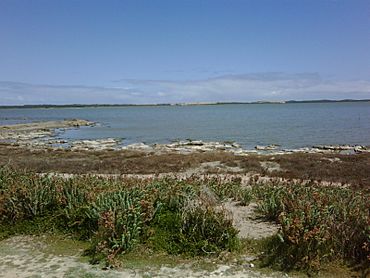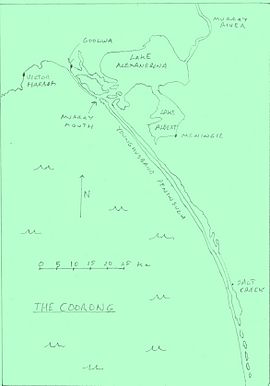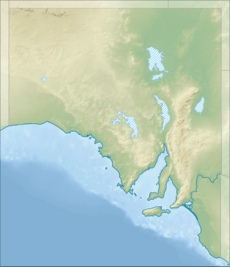Coorong National Park facts for kids
Quick facts for kids Coorong National ParkSouth Australia |
|
|---|---|
|
IUCN Category II (National Park)
|
|

The view across the Coorong near Salt Creek
|
|

A map of the Coorong
|
|
| Nearest town or city | Goolwa |
| Established | 9 November 1967 |
| Area | 490.15 km2 (189.2 sq mi) |
| Managing authorities | Department for Environment & Water |
| Website | Coorong National Park |
| Footnotes | |
| Official name: The Coorong, Lake Alexandrina & Albert Wetland | |
| Designated: | 1 November 1985 |
| Reference #: | 321 |
| See also | Protected areas of South Australia |
Coorong National Park is a special protected area in South Australia. It is about 156 kilometers (97 miles) south-east of Adelaide. The park mostly covers a long coastal lagoon system called The Coorong. It also includes the Younghusband Peninsula, which is a strip of land on the Coorong's southern side.
The Coorong lagoon starts near the Murray Mouth (where the Murray River meets the ocean). It stretches about 130 kilometers (81 miles) to the south-east. You can reach the park by road from Meningie. The long beach on the ocean side of the peninsula is also often called The Coorong. The Ngarrindjeri people, an Aboriginal Australian group, are the traditional owners of this land.
Some well-known spots in the park include Salt Creek, Policeman's Point, Jack Point, and Woods Well.
Contents
What's in a Name?
The name "Coorong" is believed to come from the Ngarrindjeri word kurangk. This word means a long or narrow lagoon or neck.
Park History
Coorong National Park was officially created on November 9, 1967. This happened under the National Parks Act 1966. Later, on April 27, 1972, more land was added to the park.
In 1993, a special area called the Coorong Game Reserve was also added to the national park. This reserve was bought by the government in 1968. It covered part of the Coorong lagoon near Salt Creek.
In 2013, a lifeboat from a ship called MS Oliva washed ashore in the park. The ship had sunk in the South Atlantic in 2011.
About the Park
The Coorong lagoon starts where the Murray River meets the ocean, near Hindmarsh Island. It stretches about 130 kilometers (81 miles) to the south-east. The national park includes the Coorong lagoon itself. It also has the Younghusband Peninsula, which separates the lagoon from the Southern Ocean.
The park was created in 1967 to protect many types of birds, animals, and fish. It is a very important place for birds that migrate (travel long distances). It also provides a safe home for animals during Australia's dry periods. The park covers about 467 square kilometers (180 square miles). It also protects coastal sand dunes and special plants that grow near the coast.
A unique feature of the Coorong is how different waters mix. Sea water and Murray River water meet rainfall and groundwater here. The fresh water helps the animals, while the sea water is home to many birds.
The waters of the Coorong are popular for fishing. People catch fish like Coorong mullet, mulloway, and bream.
Australia's Longest Beach
The sandy beach on the outer side of the Younghusband Peninsula is about 194 kilometers (121 miles) long. It is often called The Coorong and is the longest beach in Australia. It runs from the Murray Mouth all the way to Cape Jaffa.
Cultural Importance
The Coorong is very important to the Ngarrindjeri people. They have many traditional stories and songs about how the area was created. They have also lived here for a very long time, taking care of this special environment.
Camp Coorong
Camp Coorong is a place where visitors can learn about Ngarrindjeri culture. You can learn about their history, art, and crafts, like basket-weaving. Ngarrindjeri people own and run the center. It is located about 11 kilometers (7 miles) south of Meningie.
Brothers Tom and George Trevorrow started the center in 1985. Their goal was to create a place for the local community to have camps. They also wanted to provide jobs for younger community members. Most importantly, they wanted to share Ngarrindjeri culture. The center officially closed to the public in 2018.
Aunty Ellen Trevorrow, a well-known Ngarrindjeri weaver, works from the camp. She is Tom's widow. Artist Jelina Haines also works there. Their artwork has been featured in government offices in Pirie Street.
Park Environment
The wetlands in Coorong National Park are a complex ecosystem. They have fresh, salty, and very salty water bodies. This creates many different habitats for plants and animals. However, these coastal lagoons are considered critically endangered. This is because less fresh water flows into them. Also, some special water plants have disappeared, leading to a loss of different habitats.
In 2018, the Australian and South Australian governments started a new program. It is called "Healthy Coorong, Healthy Basin." As of 2021, the Ngarrindjeri Aboriginal Corporation is working with the Department for Environment & Water. They are sharing their knowledge of landcare practices. This knowledge will be added to a new database.
Animals and Plants
The Coorong is home to a huge variety of natural life.
Birds
BirdLife International has recognized Coorong National Park as an Important Bird Area. Many bird species live here, including the chestnut teal and Australian shelduck. You can also find sharp-tailed sandpipers, red-necked stints, and banded stilts. Other birds include red-necked avocets, pied oystercatchers, and red-capped plovers. Australasian bitterns have also been seen.
The park used to be home to many orange-bellied parrots, fairy terns, and hooded plovers. However, their numbers have gone down because there is less fresh water.
The largest pelican rookery (breeding colony) in Australia is at Jack Point. It is just off the Princes Highway, about 7 kilometers (4 miles) north of Salt Creek. Pelicans also breed on North Pelican Island. The Australian pelican (Pelecanus conspicillatus) is the largest type of pelican. They breed from August to January.
Marine Life
As mentioned, Coorong mullet, mulloway, and bream are the main fish caught in the Coorong. These fish are popular for people to eat.
In Books and Movies
The park was the setting for the popular 1976 film Storm Boy. It was also used for the 2019 remake. Both movies are based on the 1964 novel by Colin Thiele. The story is set on the Coorong and is about a young boy. He rescues and raises a special orphaned pelican named Mr Percival.
Lucy Treloar's award-winning novel, Salt Creek (2015), is also set in the Coorong. It takes place around Salt Creek in 1855.
Images for kids
-
Sunset over the northern part of The Coorong, approaching the town of Meningie, South Australia.
-
Flock of banded stilts on sand flats at the Coorong.
-
Entrance to The Coorong (mid-distance) looking from Hindmarsh Island.
See also
 In Spanish: Parque nacional Coorong para niños
In Spanish: Parque nacional Coorong para niños






